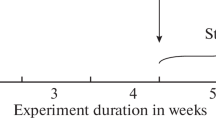Summary
In experiments with dogs (n=43), we studied the influence of different temperatures on the hind leg subjected to an isolated perfusion over a period of 1 and 2 h. The main supplying vessels of a hind leg were clamped, cannulated, and connected to an extracorporeal circulation unit which consisted of a roller pump, an oxygenator, and a heat exchanger. Whole blood was used for the regional perfusion at a flow rate of 10 ml·min−1·100 g−1 of tissue. Intramuscular (i.m.) temperatures were set at 38°, 40°, 42°, and 43.5°C, respectively. The perfusion pressure, the osmotic resistance of the erythrocytes and the metabolic status in specimens of skeletal muscle obtained at the end of the perfusion period or after an 8-day follow-up observation served as parameters. A perfusion of 1 and 2 h at temperatures of up to 42°C did not result in alterations of the energy metabolism. When the i.m. temperature was raised to 43.5°C, a significant decrease in muscular high-energy compounds and an accumulation of lactate occurred. Only under this condition was there a rise in the perfusion pressure and a drastic reduction in the blood pH value in the venous line of the extracorporeal circulation. Acidosis and hyperthermia of 43.5°C produced a marked reduction in the osmotic resistance of the erythrocytes.
Similar content being viewed by others
References
Abood LG, Koketsu K, Miyamoto S (1962) Outflux of various phosphates during membrane depolarisation of excitable tissue. Am J Physiol 202:469–474
Boeckl O (1965) Probleme der regionalen Perfusionstherapie maligner Tumoren. Wien Klin Wochenschr 77:856–858
Bollmann JL, Flock EV (1944) Changes of phosphate of muscle during tourniquet shock. Am J Physiol 142:290–297
Cavaliere R, Ciocatto EC, Giovanella BC, Heidelberger C, Johnson RO, Margottini M, Mondive B, Moricca G, Rossi-Fanelli A (1967) Selective heat sensitivity of cancer cells. Biochemical and clinical studies. Cancer 20:1351–1383
Cavaliere R, di Filippo F, Moricca G, Santori F, Varanese A, Cavallari A, Carlini S, Brunori M, Aloe L, Monticelli G (1982) Hyperthermia and chemotherapy by regional perfusion for tumors of the extremities. In: Gautherie M, Albert E (eds) Biomedical thermology. Liss, New York, pp 775–783
Chandler BM, Sonnenblick EH, Spann JE, Pool PE (1967) Association of depressed myofibrillar adenosine triphosphate and reduced contractility in experimental heart failure. Circ Res 21:717–725
Creech O, Krementz ET, Ryan RF, Windblad JN (1958) Chemotherapy of cancer: regional perfusion utilizing an extracorporeal circuit. Ann Surg 148:616–632
Ghussen F, Nagel K, Sturz J, Isselhard W (1982) A modified dye dilution method to estimate regional isolated perfusion of the extremity. Res Exp Med (Berl) 180:179–187
Ghussen F (1981) Tierexperimentelle und klinische Untersuchungen zur regionalen hyperthermen Extremitätenperfusion bei der Behandlung des malignen Melanoms. Habilitationsschrift, Köln
Imai S, Riley AL, Berne RM (1964) Effect of ischaemia on adenine nucleotides in cardial and skeletal muscle. Circ Res 15:443–450
Isselhard W, Merguet H (1962) Metaboliten des Glykolyse-Cyclus und des Adenylsäure-Phosphokreatin-Systems in schlagenden und durchbluteten Warmblüterherzen unter verschiedenen Versuchsbedingungen. Pflügers Arch 276:211–235
Isselhard W, Merguet H, Palm K (1962) Bestimmung des Gesamtglykogens neben säurelöslichen Metaboliten in Perchlorsäure-Organhomogenaten. Z Gesamte Exp Med 136:174–182
Isselhard W (1964) Vergleich des Herzstoffwechsels bei verschiedenen Methoden des künstlichen Herzstillstandes und bei anschließender Reperfusion. Habilitationsschrift, Köln
Isselhard W (1965) Akuter Sauerstoffmangel und Wiederbelebung. Dtsch Med Wochenschr 90:349–356
Kovach AG, Takaes L, Szabo MT, Takacsnagy L, Zachariew G, Harmoni J (1956) Regeneration in the biochemical, functional and histological changes found in the muscle of rats after ischaemic shock. Acta Physiol Hung 10:313–325
Krementz ET, Ryan RF (1972) Chemotherapy of melanoma of the extremities by perfusion: Fourteen years' clinical experience. Ann Surg 175:900–917
Stehlin JS jr (1969) Hyperthermic perfusion with chemotherapy for cancer of the extremities. Surg Gynecol Obstet 129:305–308
Stehlin JS jr, Giovanella BC, de Ipolyi PD, Muenz LR, Anderson RF (1975) Results of hyperthermic perfusion for melanoma of the extremities. Surg Gynecol Obstet 140:339–348
Stehlin JS jr, Giovanella BC, de Ipolyi PD, Anderson RF (1979) Eleven years' experience with hyperthermic perfusion for melanoma of the extremities. World J Surg 3:305–307
Sugarbaker EV, McBride CM (1976) Survival and regional disease control after isolationperfusion for invasive stage I melanoma of the extremities. Cancer 37:188–198
Wollenberger A, Ristau O, Schoffa G (1960) Eine einfache Technik der extrem schnellen Abkühlung größerer Gewebsstücke. Pflügers Arch Ges Physiol 270:399–412
Author information
Authors and Affiliations
Additional information
Supported by a grant from the Deutsche Forschungsgemeinschaft (Gh 1 + 2)
Rights and permissions
About this article
Cite this article
Ghussen, F., Isselhard, W. The limit of hyperthermic strain on skeletal muscle tissue during regional perfusion. Res. Exp. Med. 184, 115–123 (1984). https://doi.org/10.1007/BF01852358
Received:
Accepted:
Issue Date:
DOI: https://doi.org/10.1007/BF01852358




